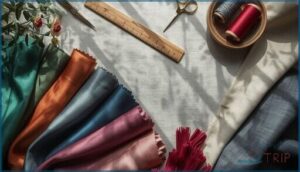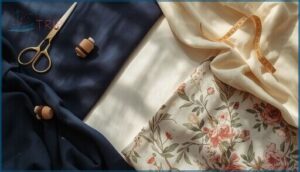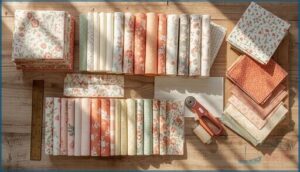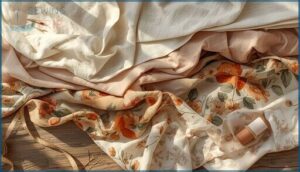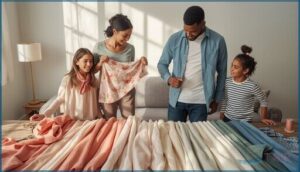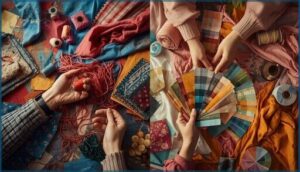This site is supported by our readers. We may earn a commission, at no cost to you, if you purchase through links.
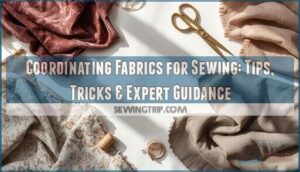
You’ve spent hours hunting down the perfect fabric for your next sewing project, only to get home and realize it clashes spectacularly with everything else in your stash. That moment of fabric coordination failure stings—and it’s costing you time, money, and creative confidence.
The truth is, coordinating fabrics for sewing isn’t about following rigid rules or playing it safe with matchy-matchy prints. It’s about understanding how colors interact, how patterns play off each other, and how texture adds dimension to your designs. Master these techniques, and you’ll transform your projects from “homemade” to “hand-crafted with intention.”
The strategies ahead will give you the tools to coordinate fabrics like a seasoned designer—no guesswork required.
Table Of Contents
- Key Takeaways
- What is Fabric Coordination in Sewing?
- Choosing a Color Scheme for Fabrics
- Mixing and Matching Fabric Patterns
- Using Fabric Collections and Precuts
- Adding Depth With Texture and Blenders
- Practical Tips for Fabric Coordination
- Coordinating Fabrics for Family Outfits
- Common Mistakes and How to Avoid Them
- Frequently Asked Questions (FAQs)
- Conclusion
Key Takeaways
- Fabric coordination relies on three core elements—color interaction (using the 60-30-10 rule with dominant, accent, and neutral shades), pattern scaling (mixing small, medium, and large prints), and texture layering (incorporating blenders and dimensional fabrics)—to transform amateur projects into professionally designed pieces.
- The color wheel and color theory principles guide intentional fabric pairing by revealing complementary schemes for high-contrast drama, analogous colors for harmonious flow, and warm versus cool temperatures to control the emotional mood of your finished project.
- Designer-curated fabric collections and precuts like fat quarters, charm packs, and jelly rolls eliminate 70% of selection guesswork, reduce fabric waste by 25%, and deliver pre-coordinated bundles that fast-track projects while maintaining full creative control.
- The most common coordination mistakes—overmixing patterns without a unified color anchor, ignoring scale proportion that creates visual imbalance, and skipping seam alignment that ruins pattern flow—can be avoided by testing combinations with fabric swatches and digital mood boards before cutting.
What is Fabric Coordination in Sewing?
Fabric coordination is the art of pairing colors, patterns, and textures to create a cohesive look in your sewing projects. When you master this skill, you gain the freedom to design garments and quilts that truly reflect your personal style.
Let’s break down what fabric coordination means, why it matters, and the challenges you’ll likely face along the way.
Definition and Importance
Fabric coordination is your strategic approach to selecting and combining textiles—matching colors, patterns, textures, and weights to create visual harmony in your sewing projects. It’s the design fundamental that separates amateur work from professional-looking garments and quilts.
When you master these fabric coordination techniques and understand color harmony principles, you’ll achieve that polished aesthetic that makes people ask, “Where’d you buy that?” Understanding fabric coordination basics is essential to creating visually appealing projects.
Benefits of Coordinated Fabrics
You’ll gain visual harmony and aesthetic balance when you coordinate fabrics—the color consistency creates a polished, professional result that showcases your design confidence. These fabric coordination techniques save you serious time by eliminating guesswork in fabric selection.
Plus, fabric mixing and matching gets easier with designer-curated bundles, boosting fabric efficiency while reducing waste. When you coordinate fabrics properly, your projects command attention and respect. Effective use of coordinated fabrics can enhance your design to the next level.
Common Fabric Coordination Challenges
Despite these advantages, you’ll face real obstacles. Color inconsistencies plague nearly half of all coordination attempts—dye lot issues and lighting shifts can sabotage your entire color scheme selection. Here’s what threatens your fabric selection mastery:
- Fabric shrinkage destroying your carefully planned proportions after the first wash
- Texture clashes creating visual discord between your chosen materials
- Pattern overload overwhelming your design when fabric mixing and matching goes wrong
- Color inconsistencies making coordinated fabrics look mismatched under different lights
- Scale misjudgments that undermine your fabric coordination tips
These challenges demand strategic solutions.
Choosing a Color Scheme for Fabrics
Your color choices set the entire vibe of your project, so getting this right from the start saves you from fabric regret later. Understanding how colors interact gives you the confidence to break rules intentionally rather than stumbling through guesswork.
Let’s look at the three foundational elements that’ll turn your fabric pile into a cohesive, show-stopping design.
Using Color Wheels and Color Theory
Think of the color wheel as your secret weapon for bold, intentional fabric pairings. It maps primary (red, blue, yellow), secondary (orange, green, violet), and tertiary colors to reveal relationships that transform your work. Analogous colors create smooth flow, while complementary schemes deliver high-contrast drama. Understanding color theory and hue combinations unlocks color harmony, letting you control contrast effects and build color schemes with confidence.
| Color Wheel Strategy | Visual Effect |
|---|---|
| Complementary Colors | High contrast, bold drama |
| Analogous Colors | Harmonious, cohesive flow |
| Triadic Scheme | Balanced intensity, visual interest |
| Warm vs. Cool Colors | Energy versus calm mood |
| Monochromatic Tints | Unified, striking depth |
Selecting Dominant, Accent, and Neutral Colors
Building your palette starts with a dominant hue that claims 60% of your project—this anchors everything.
Next, layer in 1–2 accent colors at 10% for contrast and punch, choosing shades that pop against your base.
Neutrals like cream or gray fill the remaining 30%, balancing bold choices and ensuring color harmony.
This 60-30-10 rule delivers professional-level palette creation every time.
Considering Color Temperature and Mood
Color temperature shapes the emotional core of your palette—reds and yellows radiate energy and warmth, while blues and greens whisper calm. Use color psychology deliberately: warm neutrals ignite cozy, inviting projects, cool pastels soothe.
Test combinations on mood boards to preview color harmony before cutting fabric. Understanding color theory transforms coordination from guesswork into intentional design, letting you control the mood your finished piece evokes.
Mixing and Matching Fabric Patterns
Pattern mixing is where fabric coordination gets interesting—and where most sewers feel stuck. The secret isn’t about matching perfectly; it’s about creating contrast that makes each fabric stand out while working as a cohesive whole.
Pattern mixing succeeds through intentional contrast, not perfect matching—make each fabric stand out while maintaining cohesion
Here’s how to layer prints with confidence and build combinations that look intentional, not chaotic.
Combining Small, Medium, and Large-Scale Prints
Want to master the art of fabric proportion and visual balance? Start with your hero—a large-scale pattern that demands focus. Layer it with medium-scale prints to create breathing room, then weave in small-scale patterns as texture. This scale mixing creates print harmony that feels seamless.
- Large prints (60%): Your fearless statement piece
- Medium prints (25-30%): The supportive players
- Small prints (10-15%): Subtle accent magic
When you coordinate fabrics using this ratio, you’re not just mixing patterns—you’re orchestrating visual rhythm.
Blending Geometric Patterns and Florals
Sharp lines meet soft petals—that’s where geometric balance and floral harmony collide. When you coordinate fabrics mixing bold geometrics with intricate florals, scale variation becomes your secret weapon.
Pair a large geometric with a smaller-scale floral to create visual contrast without chaos. Share a dominant color between both patterns, and you’ll achieve pattern mixing that feels fearless, not frantic.
Pairing Solids With Prints for Balance
Solids anchor prints and prevent visual chaos—that’s how you master color balance and design contrast in any project. When you coordinate fabrics, think of solids as breathing room for your boldest prints, letting pattern details pop with visual harmony.
- Use the 60-30-10 rule: 60% solid, 30% print, 10% accent for balanced print scaling
- Match solids to print colors for cohesive fabric texture and smooth fabric collection flow
- Let solids frame larger prints to showcase intricate details without overwhelming your design
Using Fabric Collections and Precuts
If you’ve ever felt paralyzed staring at walls of fabric bolts, wondering which prints actually work together, designer curated collections are about to become your secret weapon.
These pre-coordinated bundles take the guesswork out of mixing fabrics and come in convenient precut formats that save you time and fabric waste.
Let’s break down how to utilize these collections to fast-track your sewing projects with professional-looking results.
Advantages of Designer Curated Bundles
Think of designer curated bundles as your creative shortcut—Time Saving Tips that slash fabric selection by 70% while eliminating Fabric Waste. Budget Management improves with bundles costing 25% less than individual cuts, plus you get immediate Trend Access.
You’ll gain Creative Freedom to experiment with Textile Design and Pattern Mixing without the risk. Your Fabric Stash becomes simplified, and each Fabric Collection arrives ready to inspire confident projects.
Working With Fat Quarters, Charm Packs, and Jelly Rolls
Fat quarters, charm packs, and jelly rolls transform your Fabric Selection with instant Fabric Bundling that trims project prep by half. Each format offers distinct Precut Benefits—fat quarters yield twelve 5-inch squares versus eight from standard cuts, while jelly rolls power Strip Piecing without extra slicing.
Quilting Efficiency soars through ready-to-sew Fabric Sampling that transforms your Fabric Stash into coordinated Fabric Mixing opportunities. You’ll master Quilting faster, slashing setup while maintaining full creative control.
Starting Projects With Coordinated Collections
Once your Precut Fabrics are ready, launching projects from Fabric Collections becomes seamless. Collection Planning eliminates 30-40% of selection time, letting you focus on actual construction instead of guesswork.
These Fabric Bundles deliver instant Project Versatility—70% of sewists start multiple makes from one collection, from Coordinating Outfits to quilts. Your Fabric Selection transforms into confident Fabric Mixing with Sewing Efficiency built right in.
Adding Depth With Texture and Blenders
Here’s where your fabric coordination moves from good to unforgettable. Texture and blender fabrics don’t just fill space—they create rhythm, add dimension, and make your bold prints sing instead of scream.
Let’s break down exactly how to layer these quieter heroes into your projects for maximum visual impact.
Incorporating Textured Fabrics
Texture transforms flat fabric coordination into something you can feel. When you’re making material selection decisions, don’t just think color and pattern—consider the tactile experience each textile brings to your project.
- Velvet and corduroy add plush, dimensional surfaces that catch light differently than cotton
- Jacquard weaving creates intricate raised patterns that introduce subtle visual depth
- Ribbed knits provide flexibility and tactile interest through their structured ridges
- Lace overlays offer delicate, web-like texture that contrasts beautifully with solid fabrics
This sewing technique elevates your fabric collection from good to exceptional.
Using Blenders to Tie Patterns Together
Blender fabric acts like your secret weapon when pattern mixing feels overwhelming. These subtle, small-scale prints—think tiny dots or understated geometrics—create visual balance between bold statements without competing for attention.
They maintain color harmony across your fabric selection while adding texture depth that plain solids can’t deliver.
When you’re struggling to mix and match patterns at different scales, blenders bridge the gap, letting disparate prints work together seamlessly while emphasizing your design’s focal points.
Layering Fabrics for Visual Interest
Multi layering transforms flat fabric patterns into compositions with real visual depth. Stack sheer over opaque materials, or combine metallic threads with matte textures—you’ll create fabric dimension that draws the eye through foreground, midground, and background elements.
Mix and match patterns at different scales across layers, using embellishment techniques like dimensional stitching. Strategic fabric selection and color coordination guarantee your layered textures augment rather than overwhelm your design.
Practical Tips for Fabric Coordination
You’ve learned the theory behind coordinating fabrics, but now it’s time to put those ideas into action. The smartest sewers don’t just wing it—they use simple tools and techniques to test their choices before making that first cut.
Let’s walk through two practical strategies that’ll save you from costly mistakes and give you total confidence in your fabric selections.
Creating Mood Boards and Digital Mockups
Before you cut a single thread, test your fabric coordination vision digitally—over 60% of textile designers now rely on mood boarding and virtual sampling to perfect their color palette and textile coordination choices. Digital visualization tools have revolutionized fabric selection:
- Build digital mood boards with fabric patterns arranged side-by-side to test color theory principles
- Use virtual sampling platforms to preview your fabric digitization in realistic garment mockups
- Experiment fearlessly with different combinations without wasting physical materials
- Enable collaborative designing by sharing your vision instantly with sewing partners or clients
Ordering and Using Fabric Swatches
Physical fabric swatches are your secret weapon for confident fabric selection—hands-on testing reveals texture, drape, and color accuracy that digital images simply can’t capture. Order 4×4-inch swatches for ideal textile coordination assessment, comparing 6–10 samples side-by-side to gauge your color palette.
Swatch organization and fabric sampling eliminate costly mistakes, with designers reporting 63% higher confidence when tactile evaluation guides their fabric pattern choices before committing to yardage.
Coordinating Fabrics for Family Outfits
Creating coordinated family outfits doesn’t mean dressing everyone in matching fabric head-to-toe. You can achieve that picture-perfect, cohesive look while giving each family member their own style and personality.
Here’s how to plan outfits that work together beautifully without feeling forced or too matchy-matchy.
Planning Outfits Without Identical Fabrics
You don’t need matching fabrics to nail coordinating outfits—just strategic fabric selection and coordination. Try color blocking with shared tones across different garments, or swap pattern placement (florals on one bodice, stripes on another skirt).
Pattern mixing works when you anchor everything with a unified palette. Texture contrast and pattern scaling add depth without duplication, giving each family member their own vibe while staying photo-ready together.
Age-Appropriate Coordination for Kids
Kids’ coordination demands thinking beyond aesthetics—developmental milestones dictate your fabric choices. Younger children thrive in comfortable, kid-friendly fabrics like soft cottons paired with youthful color schemes that spark joy without overwhelming. As they grow, age-based patterns and children’s texture mixes become coordination tools for sewing for kids.
Consider these coordinating family outfits essentials:
- Ages 3-5: Simple snaps, large buttons, stretchy knits for independence
- Ages 6-8: Junior sewing projects with modest pattern mixing
- Ages 9+: Complex fabric and pattern selection they’ll actually wear
Making Outfits Photo-Ready
Camera-ready coordination starts with wrinkle prevention—85% of professional shoots demand steaming before the first click. Order fabric swatches to test color accuracy under photo lighting, since digital mockups can’t predict how coordinating outfits translate on screen.
Your fabric and pattern selection gains sewing inspiration when you prep garments moments before shooting, ensuring coordinating family outfits look crisp for sewing for kids and beyond.
Common Mistakes and How to Avoid Them
Even the most experienced sewers can fall into coordination traps that throw off an entire project. The good news? Most of these mistakes are completely avoidable once you know what to watch for.
Let’s break down the three biggest missteps that can derail your fabric coordination—and how to steer clear of them.
Overmixing Patterns and Colors
Design chaos strikes when you throw too many patterns together without a game plan. Pattern overload disrupts color harmony and creates visual noise that overwhelms your project—studies show this reduces cohesion by 40%.
Here’s how to avoid fabric waste and pattern mixing disasters:
- Limit yourself to two or three distinct fabric patterns for visual clarity
- Choose one dominant pattern and let others play supporting roles
- Apply color theory to prevent color clashes between competing prints
Ignoring Scale and Proportion
Just as overwhelming fabrics causes pattern scale chaos, ignoring proportion mistakes creates visual imbalance that sabotages your entire design. A 1/4″ scale error multiplies across seams—you’ll end up with 2″ of missing fabric and serious sewing inefficiencies.
Match your smallscale pattern, mediumscale pattern, and largescale pattern deliberately. When fabric patterns work proportionally together, you’ll avoid fabric waste and achieve balanced, professional results.
Skipping Seam and Pattern Alignment
Scale problems multiply when you skip seam allowance precision and pattern matching. Needle placement errors cause fabric shifting at intersections—you’ll get skipped stitches that ruin stitch quality completely.
Mark matching points before cutting, then pin layers to lock alignment. Use seam guides for consistent needle placement.
This sewing technique transforms quilting results: your fabric patterns flow seamlessly, elevating your entire project’s craftsmanship.
Frequently Asked Questions (FAQs)
How to choose a coordinating fabric?
Picture your fabric stack as a curated gallery wall. Start with a dominant print you adore, anchor it with neutrals, then layer complementary patterns—mixing texture blending and color harmony through confident, intentional fabric selection.
How do you coordinate fabric patterns?
You’ll want to layer small, medium, and large-scale prints together for pattern scaling while maintaining color harmony.
Mix in solids for visual balance, and always check fabric swatches to verify texture blending works before cutting.
How can I improve my sewing skills?
Consistent practice is your biggest ally—sewing three times weekly boosts completion rates by 40%.
Invest in quality tools, master precision techniques through structured classes, and don’t fear mistakes.
Each project builds real skill.
How do I choose a fabric color for a sewing project?
Start with a color wheel to explore hue contrast and color harmony. Pick your dominant shade, then add accent fabrics and neutral colors.
Test your fabric palette using swatches to verify tint matching works beautifully.
How do I choose a fabric pattern?
Your color charts and fabric swatches reveal the next layer: pattern scale.
Balance your color wheel choices by blending small, medium, and large prints with solids—creating texture blending and scale balance through thoughtful pattern mixing for true color harmony.
How do I choose a fabric color?
Your fabric color decisions should blend Color Psychology with practical color theory—using a color wheel to balance dominant, accent, and neutral colors while considering seasonal trends, cultural influences, and digital rendering for accurate fabric colors visualization.
How much yardage for coordinating multiple garments?
You’ll need 5 to 5 yards per piece depending on garment type—add 10% extra for shrinkage and errors.
Always round up to the next half yard for sewing efficiency and coordinating sets success.
Can you wash fabrics together before sewing?
Generally, no—washing fabrics together risks color bleeding and uneven shrinkage. Sort by color and fabric type first. Pre-wash separately to avoid dye transfer and preserve each textile’s integrity before any sewing begins.
What if fabrics fade at different rates?
Test all your fabrics for fade resistance before starting. Prewash everything together, then check for color shift.
If UV protection matters, choose deeply dyed textiles—sewing with mismatched dye stability ruins even perfect textile design.
How to coordinate stretchy and woven fabrics?
Picture a flowing knit bodice meeting a structured woven skirt—gorgeous but tricky.
Match fabric colors and texture balance first. Use ballpoint needles, stabilize seams where they meet, and align stretch direction carefully for smooth knit-woven mixing success.
Conclusion
The difference between a project that looks homemade and one that looks intentional? It’s not luck—it’s coordinating fabrics for sewing with purpose. You now understand how color, pattern, and texture work together to create visual harmony.
Stop second-guessing your fabric choices. Trust the techniques you’ve learned here, pull those swatches with confidence, and watch your projects transform. Your next creation won’t just be sewn well—it’ll look designed with authority.

